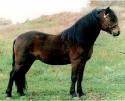
- Dartmoor - |
|||
|
The Dartmoor has ancient
roots and has had a very checkered past, which nearly resulted in
the extinction of the breed a number of times. The Dartmoor is one
of England's native pony breeds and for centuries has lived in a
semi-wild state in the open moorlands of Dartmoor in Devon. Although
they can still be seen there, the majority of the ponies are now
kept and bred in private stables. Through time the Dartmoor
pony has been noted for its excellent qualities and abilities, including
a natural jumping ability. It has benefited further during the 20th
century from infusions of blood from a variety of other breeds.
Significant contributions to the modern Dartmoor pony came from
the Arabian stallion Dwarka, foaled in 1922, and his son The Leat,
as well as the Welsh Mountain pony Dinarth Spark. The Dartmoor suffered
severely from 1789 to 1832, which saw the birth of the industrial
revolution. The breed was infiltrated
greatly by Shetland blood to produce suitable pit ponies, which
resulted in a decrease of good, pure-bred stock. Revived through
the use of Welsh Mountain ponies and Fell stallions, the breed again
suffered large losses during WWI. The Second World War almost saw
the breed's extinction as its natural habitat was taken over by
the army for training exercise. Dartmoor ponies are in
high demand as children's ponies and as show ponies. They have excellent
dispositions, are sweet-tempered, willing, and naturally athletic.
They jump incredibly well, move very well, and are quite often used
as foundation stock for the breeding The Dartmoor pony is a
quality riding pony and also suitable for use in harness. They are
nicely proportioned and put together, with good conformation. They
have fine, attractive heads set on a muscular neck. a compact back,
and strong legs with short cannon bones. They also have very full
manes and tails, and should be somewhat muscular through the back,
back, and loins. The most preferable colors are brown, black, and
bay with minimal white markings. Skewbald and piebald colors are
not accepted into the breed register at all. Dartmoor ponies stand
about 12.2 hands high.
Full Running Martingale Carry-All Trail Bag Dressage Saddle Pad Exmoor Chrome Stirrups
|
|||
|







